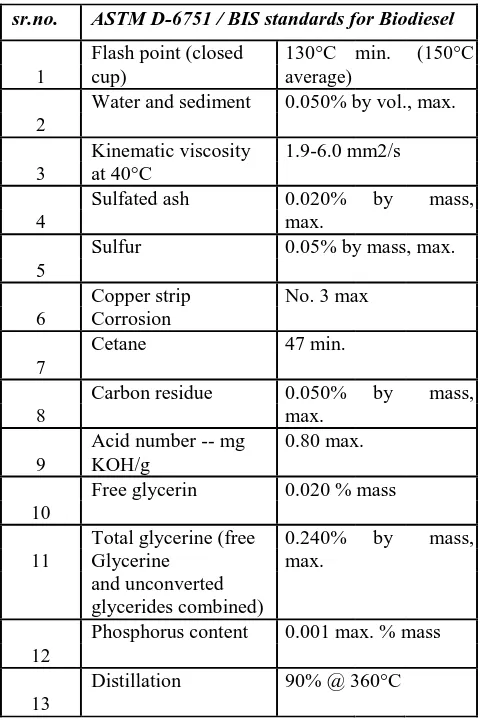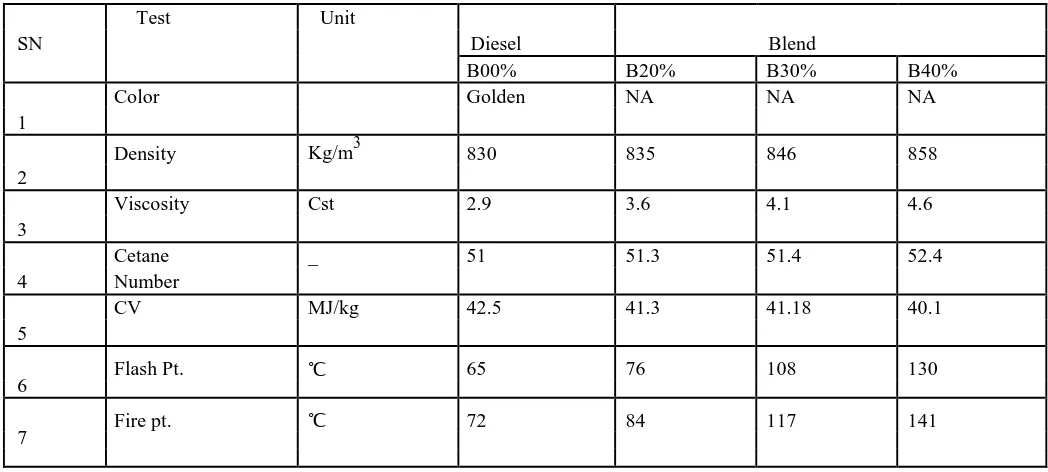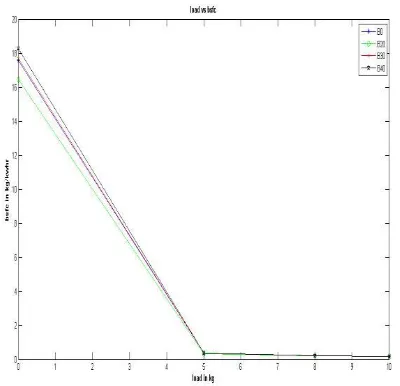Experimental Investigation of the use of Orange Peel Oil as a
Blend with Cotton Seed Oil as Alternate Fuel for CI Engines
Prof. A V Kulkarni
1, Dr. K N Bharath
2, Dr. Shreeramshastri Chavali
3, Dr. R S Jahagirdar
41AP - Mechanical Engineering Department, D Y Patil College of Engineering, Ambi, Pune
2Professor, Mechanical Engineering, GM Institute of Technology, Davangere, Karnataka
3
Professor-Mechanical Engineering Department, D Y Patil College of Engineering, Ambi, Pune
4Principal and Professor in Mechanical, K G Reddy College of Engineering & Technology, Hyderabad
Email: atkul3085@gmail.com
Abstract— As a renewable, sustainable and alternative fuel for compression ignition engines, biodiesel instead of diesel has been
increasingly leads to study its effects on engine performances and exhaust emissions in the recent 15 years. But these studies have been not properly reviewed to favor understanding and popularization for biodiesel so far. The use of biodiesel as alternate fuel leads to the decrease in fuel consumption and increase in break thermal efficiency. Biodiesel can be used in conventional diesel engines with no or few modifications. It also suits to reduce carbon deposits and wear of the key engine parts. Therefore, the blends of biodiesel with small content in place of petroleum diesel can help in controlling air pollution and easing the pressure on scarce resources without significantly sacrificing engine power and economy. The test with various blends of biodiesels is conducted on variable compression ratio CI engine. The results are analyzed. B20 blend is found suitable for improving performance & reducing engine emissions.
Keywords—Biodiesel blends, Thermal Efficiency, Emissions, bsfc
1. INTRODUCTION
CI engine plays major role in automobile industry in current scenario. Reduction in emissions and solving the energy crisis, designing CI engines with low emission and less energy consumption has always be an objective for researchers across the globe. However, with the development of new technologies, today‘s diesel engines have better emission characteristics and the less energy consumption compared with its predecessor. But, still lot of research on diesel engines aimed to achieve goal of clean and effective diesel engine. Accordingly, research on a clean burning fuel instead of conventional fuel is advisable, which could not only decrease exhaust gas to a great extent, but, also provide more options of energy sources. The use of alternative fuels for internal combustion engines has attracted a great deal of attention due to fossil fuel crisis and also GHG impact. Successful alternative fuel should comply environmental and energy security needs without reducing engine operating performance. Most biodiesel oils, particularly of the non-edible type can be used as fuel in diesel engines. One of the promising alternative fuels considered for diesel engine is biodiesel.
Biodiesel fuels are renewable, as the carbon released by the burning of biodiesel fuel is used when the oil crops undergo photosynthesis. Biodiesel also offers the advantage of being able to use in existing diesel engines without engine
alterations. The alkyl monoester of fatty acids as bio-diesel which was obtained from renewable oil and fats materials by transesterification reaction is a good alternative. Biodiesel can be obtained from raw vegetable oil by transesterification with methanol or ethanol after chemical reactions. Vegetable oils present a very promising alternative to diesel oil since they are
renewable and have similar properties as of diesel. Many researchers have studied the use of vegetable oils in diesel engines. This recommends the intensive studies on the use of alternative fuels especially renewable ones like vegetable oils and alcohols. Biodiesels such as Jatropha, Karanja, Sunflower and cottonseed are some of the popular biodiesels currently considered as substitute for diesel.
When biodiesel is used as a substitute for diesel, it is highly essential to understand the parameters that affect the combustion phenomenon which will in turn have direct impact on thermal efficiency and emission. In the present energy scenario lot of efforts is being focused on improving the thermal efficiency of IC engines with reduction in emissions. The problem of increasing demand for high brake power and the fast depletion of the fuels demand severe controls on power and a high level of fuel economy.
1.1 Criteria for a Fuel to be Engine Fuel
In IC engine, the thermal energy is released by burning the fuel in the engine cylinder. The combustion of fuel in IC engine is quite fast but the time needed to get a proper air/fuel mixture depends mainly on the nature of fuel and the method of its introduction into the combustion chamber.
The fuel should therefore satisfy the following performance. 1. High energy density.
2. Good combustion characteristics. 3. High thermal stability.
7. Low toxicity. 8. Less pollution.
Table 1.1: ASTM D-6751 / BIS standards for Biodiesel
9. Easy transferability and onboard vehicle storage. The combustion process in the cylinder should take as little time as possible with the release of maximum heat energy during the period of operation. Longer operation results in the formation of deposits which in combination with other combustion products may cause excessive wear and corrosion of cylinder, piston and piston rings. The combustion product should not be toxic when exhausted to the atmosphere. These requirements can be satisfied using a number of liquid and gaseous fuels. The biodiesel from non edible sources like Jatropha, Pongamia, Mahua, Neem etc. meets the above engine performance requirement and therefore can offer perfect viable alternative to diesel oil in India.
1.2 Biodiesel Standard
Biodiesel has a number of standards for its quality. The European standard for biodiesel is EN 14214, which is translated into the respective national standards for each country that forms the CEN(European Committee for
Standardization) area e.g., for the United Kingdom, BS EN 14214 and for Germany DIN EN 14214. It may be used outside the CEN area as well. The main difference that exists between EN 14214 standards of different countries is the national annex detailing climate related requirements of biodiesel in different CEN member countries.
1.3 Features of Biodiesel 1. Biodiesel is a clean burning fuel
2. Biodiesel does not have any toxic emissions like mineral diesel
3. Biodiesel is made from any vegetable oil such as Soya, Rice bran, Canola, Palm, Coconut, mustard or peanut or from any animal fat like Lard or tallow.
4. Biodiesel is a complete substitute of Mineral diesel (HSD). Biodiesel is made through a chemical process which converts oils and fats of natural origin into fatty acid methyl esters (FAME). Biodiesel IS NOT vegetable oil.
5. Biodiesel is intended to be used as a replacement for petroleum diesel fuel, or can be blended with petroleum diesel fuel in any proportion.
6. Biodiesel does not require modifications to a diesel engine to be used.
7. Biodiesel has reduced exhaust emissions compared to petroleum diesel fuel.
8. Biodiesel has lower toxicity compared to petroleum diesel fuel.
9. Biodiesel is safer to handle compared to petroleum diesel fuel.
10. Biodiesel quality is governed by ASTM D 6751 quality parameters.
1.4 Characteristics of Cottonseed oil:
India is the fifth largest cotton producing country in the world today, the first-four being the U.S, china, Russia and Brazil. Our country produces about 8% of the world cotton. Cotton is a tropical plant. Cottonseed oil is a vegetable oil extracted from the seeds of the cotton. After being freed from the linters, the seeds are shelled and then crushed and pressed or treated with solvents to obtain the crude cotton seed oil. Cotton seed oil is one of the most widely available oils and it is relatively inexpensive.
sr.no. ASTM D-6751 / BIS standards for Biodiesel
Flash point (closed 130°C min. (150°C
1 cup) average)
Water and sediment 0.050% by vol., max. 2
Kinematic viscosity 1.9-6.0 mm2/s 3 at 40°C
Phosphorus content 0.001 max. % mass 12
1.5 Comparisons of Properties of Biodiesel & Diesel:
Table 1.2: Properties of Biodiesel and Diesel comparisons
Test Unit
SN Diesel Blend
B00% B20% B30% B40%
Color Golden NA NA NA
1
Density Kg/m3 830 835 846 858
2
Viscosity Cst 2.9 3.6 4.1 4.6
3
Cetane _ 51 51.3 51.4 52.4
4 Number
CV MJ/kg 42.5 41.3 41.18 40.1
5
6 Flash Pt. ℃ 65 76 108 130
7 Fire pt. ℃ 72 84 117 141
2. EXPERIMENTAION
2.1 Experimental Setup
The setup consists of single cylinder, four stroke, VCR (Variable Compression Ratio) Diesel engine connected to eddy current type dynamometer for loading. The compression ratio can be changed without stopping the engine and without altering the combustion chamber geometry by specially designed tilting cylinder block arrangement. The signals are interfaced to computer through engine indicator for Pθ−PV diagrams. Provision is also made for interfacing airflow, fuel flow, temperatures and load measurement. The set up has
stand-alone panel box consisting of air box, two fuel tanks for duel fuel test, manometer, fuel measuring unit, transmitters for air and fuel flow measurements, process indicator and engine indicator. Rotameters are provided for cooling water and calorimeter water flow measurement. The setup enables study of VCR engine performance for brake power, indicated power, frictional power, BMEP, IMEP, brake thermal efficiency, indicated thermal efficiency, Mechanical efficiency, volumetric efficiency, specific fuel consumption, A/F ratio and heat balance.
Table 2.1: Engine Specifications:
Product: VCR Engine test setup 1 cylinder, 4 stroke, Diesel
(Computerized)
Product code: 234
Engine: Make Kirloskar, Type 1 cylinder, 4 stroke Diesel,
water cooled, power 3.5 kW at 1500 rpm, stroke 110 mm, bore 87.5 mm. 661 cc, CR 17.5, Modified to VCR engine CR range 12 to 18
Dynamometer: Type eddy current, water cooled, with
loadingunit
Propeller shaft: With universal joints
Air box: M S fabricated with orifice meter and manometer
Fuel tank: Capacity 15 lit with glass fuel metering column
Calorimeter: Type Pipe in pipe
Piezo sensor: Range 5000 PSI, with low noise cable
Crank angle sensor: Resolution 1 Deg, Speed 5500 RPM
with TDC pulse.
Data acquisition device: NI USB-6210, 16-bit, 250kS/s.
Piezo powering unit: Make-Cuadra, Model AX-409.
Digital milivoltmeter: Range 0-200mV, panel mounted
Temperature sensor: Type RTD, PT100 and Thermocouple,
Type K
Temperature transmitter: Type two wire, Input RTD
PT100, Range 0–100 Deg C, Output 4–20 mA and Type two wire, Input Thermocouple, Range 0–1200 Deg C, Output 4– 20 mA
Load indicator: Digital, Range 0-50 Kg, Supply 230VAC
Load sensor: Load cell, type strain gauge, range 0-50 Kg
Fuel flow transmitter:DP transmitter, Range 0-500 mm WC
Air flow transmitter: Pressure transmitter, Range (-) 250 mm
WC
2.2 Design of Experiment 1. Selection of control parameters
The following control parameters are selected for the experimental investigation with the three levels.
Table 2.2: Control parameters and their levels
Factors Level 1 Level 2 Level 3
Blend Ratio (%) 20 30 40
Load (kg) 5 8 10
Speed (rpm) 1520 1510 1490
2. Selection of Taguchi orthogonal array Factors: 3 and Levels: 3
A L9 orthogonal array with three columns and nine rows is considered for experiments & analysis.
2.3 Analysis Method
Experiment is planned according to Taguchi‘s L9 orthogonal array, which has 9 rows corresponding to the number of testes with 3 columns at three levels as shown in table. The first Signal to Noise (S/N) ratio. The category the higher-the better for Brake Thermal Efficiency and smaller the better for Brake Specific Fuel Consumption will be used to calculate the S/N ratio for finding optimum set of parameters.
1. Determination of fuel consumption:
Fuel tank is attached with a graduated burette. The valve at the bottom of the tank is closed when fuel consumption rate is to be measured so that fuel is consumed only from the burette. The time taken for ‗x‘ amount of fuel consumption is recorded to measure the fuel consumption rate.
2. Determination of brake power:
The equivalent load ‗W‘ is recorded from the calibrated circular scale incorporated in the dynamometer setup. Brake power is obtained by using the formula:
B.P = (πDWN)/60 Where,
D is diameter of the brake drum in mm N is speed of the engine in r/min
3. Determination of brake thermal efficiency Brake thermal efficiency= (B.P x3600)/ (mf x C.V) Where,
mf is fuel consumption in kg/h
C.V is calorific value of the fuel used in MJ/kg
4. Grey analysis and weighting factor assigning to the response parameters and obtaining optimal levels of engine performance process parameters. Finally, confirmation experiments will be conducted.
3. EXPERIMENTAL ANALYSIS
3.1 Response Table For Efficiency
Table 3.1 Response table for efficiency
LEVEL1 BLEND LOAD SPEED
1 41.70 26.92 39.76
2 40.23 41.14 40.85
3 38.11 51.98 39.43
DELTA 3.58 23.06 1.42
RANK 2 1 3
Result:-
1. As the load increases the speed decreases so the delay time decreases & the efficiency increases.
2. As the blend mixture increases efficiency decrease from DOE.
3.2 Orthogonal Array:-
From the below table we can see that 20% blend has the highest efficiency (54.31) & s/n ratio (34.6976) in experiment number 03.
S/N Ratio: - (bigger is the better)
Table 3.2 Optimization for blending mixture
S Blen Load Speed Efficiency S/N Ratio N D
1 20 5 1522 27.18 28.6850
2 20 8 1512 43.60 32.7897 3 20 10 1493 54.31 34.6976
4 30 5 1512 28.88 29.2119
5 30 8 1493 40.26 32.0975 6 30 10 1522 51.56 34.2463 7 40 5 1493 24.70 27.8539 8 40 8 1522 39.56 31.9451
9 40 10 1512 50.08 33.9933
3.3 Comparison Graph
Graph 3.1 Load Vs blend & efficiency
Graph 3.2 Main Effects Plot for Means
4. RESULTS AND CONCLUSION
Graph 4.1 Variation of BTh efficiency with load
1 B20 blend is the optimum mixture of cotton seed & orange peel oil in diesel having higher S/N ratio of 34.697.
2 B20 blend shown more overall efficiency of the engine as compared to diesel and has break thermal efficiency higher i.e. 54.31% as compared to other blends.
3 B20 blend gives lower BSFC of the engine is less i.e. 0.16 kg/kwhr as compared to diesel.
REFERENCES
1] S. Kirankumar, ―Experimental Investigation on Performance, Combustion Characteristics of Diesel Engine by
Using Cotton Seed Oil”, International Journal of Engineering
Trends and Technology (IJETT) – Volume 5 number 1 - Nov 2013, pp. 47-53.
2] R. Senthil Kumar and R. Manimaran, ―Performance and emission characteristics on 4-stroke single cylinder C. I.
Engine using cottonseed bio fuels”, Asian Journal of
Engineering Research, ISSN-2319–2100, Vol. I, Issue II, Jan.-March.2013
3] M. Martin and D. Prithviraj, “Performance of Pre-heated Cottonseed Oil and Diesel Fuel Blends in a Compression
Ignition Engine”, Jordan Journal of Mechanical and Industrial
Engineering, Volume 5, Number 3, June 2011 ISSN 1995-6665 Pages 235-240
4] K. Dilip Kumar and P. Ravindra Kumar, ―Experimental Investigation of Cotton Seed Oil and Neem Methyl Esters as
Biodiesel on CI Engine‖, International Journal of Modern
Engineering Research (IJMER), ISSN: 2249-6645, Vol.2, Issue.4, July-Aug 2012, pp.1741-1746
5] A. V. Krishna Reddy, M. Shiva Shankar and K. Apparao,
“Experimental Determination Of Brake Thermal Efficiency
And Brake Specific Fuel Consumption Of diesel engine fuelled
with biodiesel”, International Journal of Engineering and
Technology Vol.2 (5), 2010, pp. 305-309
6] M. Harinathareddy, Dr P. Nageswara Reddy and Dr. K. Vijayakumar reddy, “Experimental Investigation of Compressed Ignition Engine Using Cotton Seed Oil Methyl Ester as Alternative Fuel‖, International Journal of Engineering and Science ISBN: 2319-6483, ISSN: 2278-4721, Vol. 2, Issue 1 (January 2013), pp. 06-10.
7] ShyamKumar Ranganathan, Anil Gandamwad & Mayur Bawankure,“Performance evaluation of C.I. engine with
cottonseed oil”, International Journal of Instrumentation,
Control and Automation (IJICA) ISSN: 2231-1890, Vol-1 Iss-3, 4, 2012, pp. 23-27.
8] S. Naga Sarada, M. Shailaja, A.V. Sita Rama Raju1and K. Kalyani Radha, ―Optimization of injection pressure for a compression ignition engine with cotton seed oil as an
alternate fuel”, International Journal of Engineering, Science
and Technology, Vol. 2, No. 6, 2010, pp. 142-149
9] P P Patnaik, S K Acharya, “Effect of Compression Ration
on Emission of CI Engine using Neat Karanja Oil and
Karanja Oil Methyl ester Blends”, International Journal of
Engineering, Volume-27, N0-3, March 2014, pp. 403-410.
10] Parag Saxena, Sayali Jawale and Milind H Joshipura, ― A Review on prediction of properties of biodiesel and blends of biodiesel‖, SciVerse ScienceDirect, Procedia Engineering, 2013, pp. 395-402
11] ―A Comprehensive Analysis of Biodiesel Impacts on Exhaust Emissions‖, Draft Technical Report from United States Environmental Protection Agency, Oct-2002
12] Jagadish Sounagoudra, G Manvendra and S Kumarappa, “ Effect of Injection Pressure on the Performance and Emission Characteristics of Single Cylinder Diesel Engine Using Esterified Cottonseed Oil and Neemseed Oilas as Biodiesel” International Journal of Innovative Research in Science, Engineering & Technology, Vol. 2, Issue 8, August 2013, 3956-3963.


